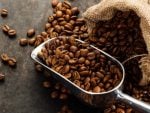Lexicon
Learn more coffee words
A
Aftertaste
Aftertaste is the taste that remains in the mouth after swallowing a sip of coffee and it may have hints of chocolate, caramel, spiciness, fruitiness, smokiness, roastiness, and other flavours.
Arabica
The most important species of commercially-used coffee plant, accounting for roughly 65% of global production, is Coffea Arabica. Its ideal climate is a tropical-mountainous one, preferably one that is over 900 metres above sea level.
Aroma
‘Intensity’ and ‘quality’ are the two main characteristics taken into consideration when the nose approaches the cup and the olfactory receptors come into contact with the aromas released by the drink.
B
Blend
Coffee blends are mixtures of different coffee bean crops. They can be made with coffees from around the world (e.g. Ethiopia, Columbia, India), regional blends (South & Central America) or a mixture of the two. It is not uncommon to find coffee blends including beans from several separate places, although an expert roaster will typically use beans from anywhere between two to a maximum of four different locations.
Body
The ‘body’ of an espresso is another way to describe how it feels in the mouth – consistent and heavy but ranging from light to full. If the description is positive, terms like soft, syrupy, creamy, buttery/oily, silky will be used, negative descriptors are dry and astringent.
Brewing
Brewing is the process of pouring hot water onto ground coffee beans, which infuses the ground coffee, absorbs its chemical elements then passes through a filter and produces a delicious coffee. There are many different brewing methods, with different percolation times: an espresso, for example, only has 20 to 30 seconds of contact between the coffee and the water.
C
Coffee belt
Coffee belt is the band of subtropical regions that stretches around the world and across 50 countries, where many of the most luscious coffee plants are cultivated: they are mostly mountainous regions that lie between the Tropic of Cancer (north of the Equator) and the Tropic of Capricorn (south of the Equator). The vast array of geographical variables including altitude, rainfall, soil conditions and sunlight, all influence the outcome of how the coffee from the different regions will taste.
Coffee waves
The First Wave consisted of mass marketers laser focused on increasing consumption of coffee: the packaging was revolutionized and air-tight cans and pre-ground portion packs were first introduced.
The Second Wave of coffee was artisan-driven. It focused on coffee origins and roasting styles. This is the era of the coffee chain giants that introduced the words ‘latte’, ‘French Roast’, and ‘cappuccino’ into the lives of consumers.
The Third Wave is related to the modern coffee roasters whose mission is simply to let the coffee speak for itself. But while the original idea was about enjoying coffee for what it is, today’s coffee consumers increasingly expect to know information about the farm, harvest, processing style, roast date, coffee variety and tasting notes before they make their coffee purchase.
E
Extraction
Extraction is simply the method used to dissolve flavours and other components from roasted, ground and compacted coffee by percolating pressurized hot water. Extraction is what defines the quality of the final result, determines the thickness of the cream on the surface and gives the coffee its fine and persistent texture.
G
Grinding
Grinding is the process of transformation of the roasted coffee beans into a coarse to fine powder, allowing oils and flavours to be extracted. This procedure can be performed with a basic, blade type grinder, or with a more sophisticated burr grinders.
P
Pre-infusion
Pre-infusion refers to the process of gently soaking the puck of ground coffee in the filter before applying the full desired brewing pressure. The goal is to ensure that water evenly penetrates the grounds so the entire bed has the same amount of water flowing through it once extraction begins.
R
Roasting
Roasting can be considered as the ‘cooking’ of the green coffee beans through the application of heat and is divided into 3 main phases: the long drying phase when the seeds lose most of the free moisture content and become yellow/cinnamon in colour. The roasting phase, during which the beans are exposed to temperatures of up to 200-230° for 12-15 mins. in a roasting machine, and chemical reactions take place that cause the seeds to take on a brown colour. Finally, the cooling phase, when the beans are brought back to room temperature.
Robusta
Coffea Robusta is the second of the two main species of coffee plants used commercially, accounting for about 35% of the world’s production of coffee. Originally named Coffea Canephora, it is particularly resistant to diseases and pests. Robusta generally has a much higher caffeine content than the other species and is mostly grown in Vietnam, but also in Africa and Brazil.
S
Single origine
The term single origin means that the beans come from one place only, usually from a certain country, region or even the same farm or estate. Many purists argue that a great single origin coffee is like a fine wine and that it’s important not to destroy its essence by mixing it carelessly with other beans. For that reason they are very popular in the specialty coffee industry, that serve a variety of seasonally offered single origins that taste very different from each other.
Specialty coffee
Specialty coffee indicates exceptional quality coffee, stored or delivered as whole beans, that need to be ground before being brewed. The extremely high standards through which specialty coffee is produced, result in a considerably wider and more distinct offer than commercial coffee (that is usually roasted and packaged in large plants, under nationally advertised brand names). Specialty coffee reaches at least 80 points on the 100-point Coffee Review scale: the SCA sets standards for specialty coffee at every stage of the coffee production, including allowable defects in green beans, water standards, and brew strength.
T
Tamping
The act of compacting ground coffee with a tamper to restrict the water flow, forcing the coffee and water to interact at the right pressure. The tamping should be firm and even, aiming to compact the coffee perpendicular to the filter without applying unnecessary force. The diameter of the tamper should be approximately 0.25mm less than that of the filter.
Taste
There are four basic flavours used to describe coffee and its taste: bitter, sour, salty, and sweet, and the predominance of any one of them depends on the composition of the blend. Sometimes, particularly for specialty coffees, umami is also perceived and described on the coffee evaluation form used during coffee tasting sessions.




















